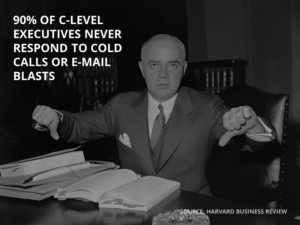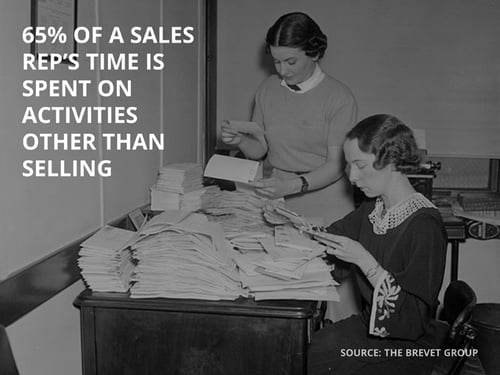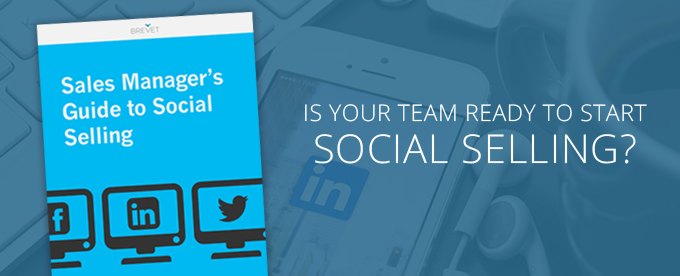Salespeople seem to have a set of rules and habits that they stick to stubbornly, no matter how much the selling environment has shifted. Your job as a sales manager, coach, and role model is to help your team evolve. In 2014, that means to get them up to speed on the benefits of social media and help them kickstart their social selling efforts.
Don’t assume your sales team “get’s it.” You need to build the case for change to get them to adopt new behavior. Use these five points to ensure your reps are ready to embrace social media strategies. See this free resource to learn even more ways you can help your sales reps become social selling rockstars.
1. Cold calling isn’t what it use to be
Cold calling has traditionally been the approach of choice for hungry, driven sales people. However the return on investment from cold calling is drastically decreasing:
- A 2012 Harvard Business Review article reported that 90% of C-level executives NEVER respond to cold calls or e-mail blasts [TWEET THIS].
- A recent IBM study found that cold calls are ineffective 97% of the time, and this number has been increasing by 7% every year since 2010 [TWEET THIS].
Replacing the decline in cold calling is the warmth of social engagement. The same HBR article also found that prospects are surprisingly open to short messages sent via social media around relevant topics initiated by the salesperson.
2. Social media is here to stay… and that’s actually a good thing
The internet changed the way we buy. Researching a purchase used to be remarkably time consuming, especially in the B2B world: multiple meetings with reps, reviewing stacks of product information, scouting out feedback from other customers. Along came the internet and it’s transformation of the sales cycle. Potential buyers are now able to do the vast majority of their research online with a simple Google search. Insight from past buyers plus third-party review and competitive comparisons are immediately available.
According to a 2012 Corporate Executive Board report, 57% of buying decisions are already made before there is any interaction between a buyer and a sales rep [TWEET THIS]. This sounds like bad news. But it’s actually not.
Social media fosters an environment where targets, prospects, and customers are publicly providing information about themselves in real time: what content they are consuming, who is influencing their thinking, and what products they are considering. What does this mean for your sales reps? This is the kind of data that can make or break a sale. This isn’t a setback, but an opportunity for salespeople to truly understand buyer needs, deliver relevant and compelling messages, find real opportunities from motivated buyers, and create more meaningful one-to-one relationships with customers.
3. Social selling works
Beyond the hype, it turns out social selling really works. Recent social selling research by the Aberdeen Group found sales professionals who are actively using social media are 79% more likely to attain their quota [TWEET THIS] than those who don’t use social selling in their sales process. It’s hard to attribute such a large performance gain to too many other things in the world of sales.
The research also found other differences between companies with stronger social selling activities than not, including larger average deal size or contract value, shorter sales cycles, and overall greater company revenue from firms with reps executing social selling strategies.
4. Your sales team has the time for it
A major concern you’ll hear from reps and often your peer managers is that their reps don’t have time for anything new. The view is that the average rep is overwhelmed just executing their regular selling activities. The truth is that your sales reps are likely spending most of their time at in non selling activity. In fact, a recent Brevet survey of sales rep activity across various industries found that 65% of a sales representative’s time is spent on activities other than selling [TWEET THIS]. This time included non-productive admin duties and other things that didn’t contribute to results. While social selling does add another item to your rep’s plate, as the previous statistics suggest, the investment appears well worth the time.
5. It’s where your customers are
The reality is that the people you want to sell to are actively using social media. Consider that just one social media platform, LinkedIn, currently has over 300 million users [TWEET THIS]. These users are business people – your current prospects, customers, and even your customer’s customer.
Using LinkedIn, Twitter, Facebook , and other social networks gives your reps valuable insight that is almost impossible to obtain through traditional means. It’s like being a fly on the wall in your customer’s, prospect’s and competitor’s world. Social media opens access into this world to find qualified leads and grow sales. For instance, a lead today might come from seeing someone complaining on Twitter that their current vendor is driving them crazy. It can be an update about a prospect’s job change or a question in a LinkedIn group. Even an unassuming comment on a Facebook page can trigger selling opportunities.
Get started
It’s time to add social selling as a core weapon in your sales team’s arsenal. Go activate and motivate your reps to start leveraging social networks in their day to day sales activities and see a real impact in their performance. For more on how to get started, download this free resource.
About The Author
 Researcher, consultant, and sales leader, Brian uses a data-driven approach to drive sales effectiveness. His clients include leading sales organizations in financial services, technology, healthcare, and professional services. Using insight from academics and change management, Brian helps senior leaders and sales enablement teams understand and succeed in today’s more demanding market. His research has been published in Harvard Business Review and other outlets.
Researcher, consultant, and sales leader, Brian uses a data-driven approach to drive sales effectiveness. His clients include leading sales organizations in financial services, technology, healthcare, and professional services. Using insight from academics and change management, Brian helps senior leaders and sales enablement teams understand and succeed in today’s more demanding market. His research has been published in Harvard Business Review and other outlets.








